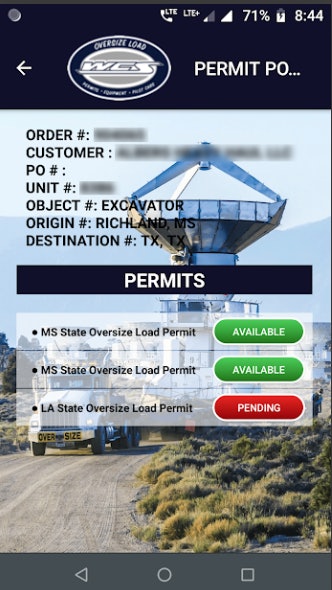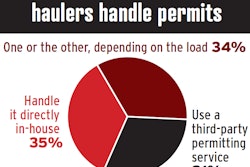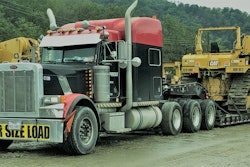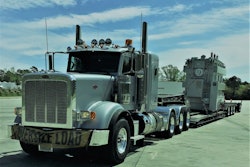Previously in this series: Harmony in states’ permitting parameters inches closer, as fines remain heavy-haul risk
Pennsylvania-headquartered Daily Express does about two-thirds of its business in heavy or oversize freight, says Erik Thompson, in fleet sales for the company. Daily also was one of the first fleets to build its own in-cab fax system, called Highway Master, back in the 1990s. It facilitated easy permit faxing to haulers of its mostly step deck and RGN rigs.
Before that, Thompson says, “guys were picking up hard copies of their oversize permits” at offices, “then we went to overnighting,” then faxing.
A Highway Master module “is probably good for a paperweight now,” he adds. Today, “drivers are getting permits on their phones” via an emailed pdf at Daily. The operator can then “keep that on his phone, though in most cases [in most states] they have to print and sign them,” as authorities guard against forgery.
And as more states come on board with auto-issue permits, technology platforms like those of ProMiles and third-party permit services like West Coast Permits continue to improve functionality for carrier users and their state counterparts when securing permits.
WCS President Wes Mollno addressed that topic as part of a panel on permit-enabling technology at the Specialized Carriers & Rigging Association’s annual transport symposium in February. He guessed that for compliance, states would continue to jump on the bandwagon of allowing electronic permits via mobile devices, reducing the need for drivers to carry paper. Twenty-six “states are allowing it today,” he said. “Two years ago I don’t think there were any.”
 West Coast Permits’ WCS Permit Portal app is used by haulers and anyone in the company needing mobile access to details on trips to improve collaborative efficiency.
West Coast Permits’ WCS Permit Portal app is used by haulers and anyone in the company needing mobile access to details on trips to improve collaborative efficiency.Ultimately, paperwork-reduction priorities among state governments may well result in paper permits being disallowed entirely, he added.
Integration of a variety of techs is underway, with GPS and route planning applications integrated with permitted trips to help guide drivers on permitted routes. In 10 years, panelists noted, such will be commonplace.
Mollno’s WCS Permit Portal and accompanying mobile app for owner-operators in the field connects a small fleet’s permit department, such as it may be, and dispatch through a central online engine. Mollno calls it “integrated permitting,” part of which is using technology to help define each party’s role in the process. It creates a central place where deadlines, status updates and other details of a project are accessible to everyone involved.
Integrated permitting allows the permit writer to order an Ohio permit, for instance, and continue to the next state along the route in Pennsylvania, and “specifically send it to our service – it allows for a little bit of guarantee with regard to compliance,” Mollno says, and the “system will auto-text and email to view the permits.”
Mobile technologies continue to change the permitting game for the small fleet owner, yet the old ways survive with some carriers and some jurisdictions’ permit departments.
Looking out over the next 10 years, “Not all states will automate routing,” for instance, predicted Tim Pilcher, president of support and development for ProMiles. And: “The last fax ever sent will be an oversize or overweight permit, but they will be few and far between.”
Pilcher’s company and Mike Morgan of Pit Row Transportation Solutions have collaborated on “Permit Manager” software that brings dynamic change notifications and collaborative management to the permitting process, in a manner similar to the WCS Permit Portal.
“It helps you route loads across multiple states with nationwide routing for oversize and overweight permits,” said Morgan. He sees it becoming increasingly common for such systems to integrate more fully with state systems to make it easy for a small fleet operating its own in-house permitting system with such software to “physically order permits from the multiple programs from each state [including local jurisdictions] with one click of the mouse – order as many at one time as you can.”
Harmonization of state permitting rules will help advance the ball, but in terms of technology and interoperability with private systems, Morgan added, states are “doing their own thing” largely speaking – private-sector “technology can really help with that,” making the interoperability of all the disparate systems more easily achieved.










